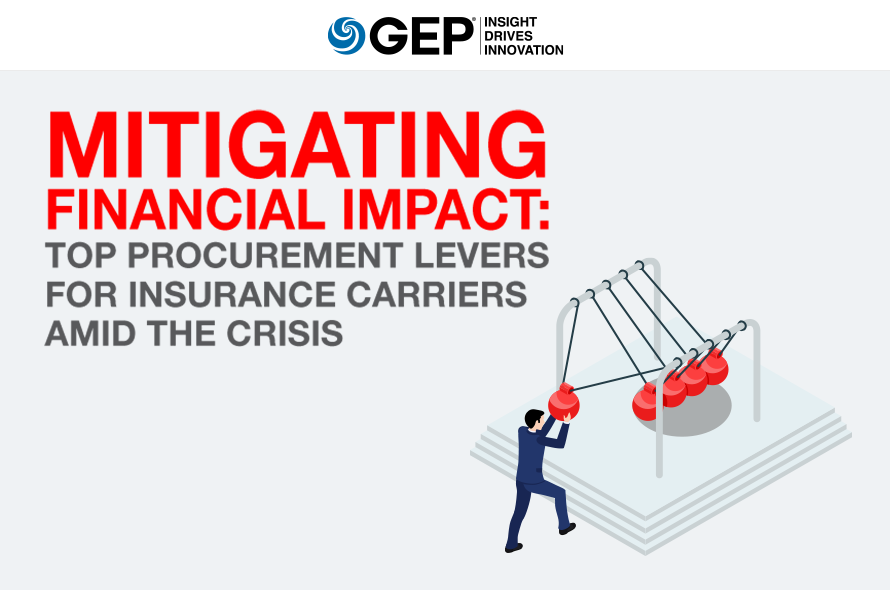In these historic times, the insurance industry should quickly adapt.
From policyholders to agents and brokers to customer-facing third parties and employees, it’s time to protect everyone’s health and safety.
And the bottom line.
Procurement has a major role to play. The latest GEP BULLETIN, Mitigating Financial Impact: Top Procurement Levers for Insurance Carriers Amid the Crisis, gives the most specific and direct guidance for strategically cutting costs without sacrificing future profits.
What’s Inside:
- How to map your supplier base quickly
- How to implement rapid sourcing and contracts
- How to leverage demand management and lower third-party risk
The bulletin is a must-read for procurement leaders in insurance who need to pivot right now.
The global outbreak of the coronavirus (COVID-19) is impacting the insurance industry from multiple dimensions — and procurement leaders are poised to play a pivotal role. Insurers around the globe are faced with challenges to ensure business continuity in the short term for the long term. It requires maintaining quality customer service while securing financial stability.
OUR TAKE: WHAT TO DO NOW AND WHY
During this unprecedented time, the insurance industry should take immediate measures to protect the health and safety of its employees, policyholders, distribution partners (agents and brokers) and all customer-facing third parties.
Insurers who have invested and implemented extensive digital capabilities are much better positioned to sustain connectivity across their workforce during this outbreak. This is also a good opportunity to conduct strategic planning and accelerate ongoing digital transformation to be better prepared for the longer-term effects of this pandemic.
The effects on claims costs will likely be specific to the types of business an insurer writes and policy wording. For Property and Casualty (P&C) insurers, the blow to their bottom-line could be low as most business disruption policies exclude coverage of communicable disease. However, P&C insurers could face potential regulatory risks from retroactive legislations to enforce coverage of coronavirus-related losses, which could threaten the stability of the sector.
For health insurance carriers, initial analysis has shown that they could face tens or up to hundreds of billions of payouts if they have to cover the full cost of testing, treatment and care related to COVID-19. As legislative actions and the sector’s ability to raise premiums to cover losses remain uncertain, all insurers should take drastic measures to ensure financial stability.
Furthermore, insurance carriers should be mindful of how the outbreak will affect the overall economic environment and need to plan for consequences that impact premium growth, underwriting and investment profitability. In the near term, insurance companies should expect the valuation of equity investments and fixed-income assets to decline because of fluctuations in equity markets and cuts in interest rates.
To sustain financial stability, effective procurement actions are crucial in driving operational efficiency, realizing savings, and boosting return on investment through management of third-party spend.
PROCUREMENT CAN HELP INSURERS MITIGATE THE FINANCIAL IMPACTS OF THIS PANDEMIC
To soften the potential impact from multiple fronts, procurement should take the following steps of mitigating operational risks to ensure business continuity and improve overall financial health.
Supplier Base Mapping
- Map out all suppliers and identify those located in high-risk areas and those whose services/products are susceptible to interruptions.
- Anticipate potential service delays and understand the risks across the supplier base. Get ready for the worst-case scenarios and identify alternative suppliers where needed.
- Evaluate contingent workforce to build geographic flexibility when local markets could experience interruptions. Engage outsourcing companies and temporary staffing agencies to free up capacity and allow front-line personnel to focus on serving the customers.
Rapid Sourcing
- Identify and benchmark high-spend areas and those prone to price fluctuations — identify quick savings opportunities.
- Conduct direct negotiations with top vendors comprising 80% of overall spend. Focus on:
- Cost reductions
- Payment term extensions
- Volume rebates and discounts
- Procurement teams should be identifying any volume and/or consumption-based penalties and renegotiating contracts to avoid minimum volume and spend commitments.
Demand Management
- Identify and cancel non-critical projects. This is a time that insurance carriers need to focus on their core business and uninterrupted customer service.
- Evaluate a temporary pause on non-essential project activities, negotiated through procurement to get the maximum cash benefit from the change.
- Negotiate extended payments for future implementation plans and multi-year products.
Third-Party Risk and Contract Management
- Implement a robust third-party risk management program with tools that effectively track and assess the operational risks of the entire supplier base in real-time
- Re-examine supplier contract requirements to mitigate long-term commercial risks. Improve the tracking and enforcement of key clauses like force majeure and recovery time metrics, payment terms, consumption commitments, etc.
- Strengthen the overall contract lifecycle management (CLM) through analytics tools.
ACCELERATE DIGITAL TRANSFORMATION WITH PROCUREMENT’S SUPPORT
Digital capabilities are paramount. Although much has been done in the industry around digital transformation over the past decade, COVID-19 will likely indicate a tipping point that requires more aggressive plans. Here are three areas procurement can support insurance carriers for their longer-term transformation:
1. Evaluate market solutions to support the digital interactions between policyholders and agents — e.g., self-service platforms, mobile apps for policy service and claims reporting, call center technologies and virtual inspections.
2. Supplement internal operations with digital tools to allow employees to work remotely as much as possible — e.g., digitize inbound documents and outbound deliveries, digital payment options.
3. Employ more stringent data management with advanced security technologies and backup solutions. Reliance on digital interactions and remote work environments increase cyber risks.
As this crisis unfolds, strengthening the financials and future-proofing the supplier base will be a major differentiator among industry leaders in the months to come. Not only will the industry and broader economy be shaken by the virus, so will the ways companies conduct business.
Many novelties may become the new norm as the workforce shifts to being more remote and digitalization becomes an imperative. Procurement can play a key role in driving the agenda in mitigating the immediate risks and optimizing the cost base to make sure companies come out of this pandemic stronger and well-positioned for the future.
RAPID RESPONSE SOLUTIONS FROM GEP
As the coronavirus crisis intensifies, managing your supply chain is going to get even more challenging. It may be worth finding a partner with deep experience in procurement and supply chain management to reinforce your capabilities and help you stay on course.
If you would like to have a conversation about how we can help, please reach out to our supply chain leadership.

Ian Cotter
Senior Director, Consulting
With over 11 years of experience, Ian is a leader in GEP's Financial Services practice and works with his client's senior leadership in: Procurement Transformation Strategy and Planning, Digital Transformation, Third-Party Risk Management, Spend Analysis, Strategic Cost Reduction, and Strategic Sourcing. Ian previously worked at Accenture in Dublin, Ireland.

